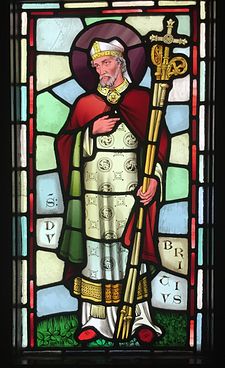Dyfrig
| Saint Dubricius | |
|---|---|

|
|
| Archbishop | |
| Born | 465(?) Madley, near Hereford, Herefordshire, England |
| Died | 550 Bardsey Island, Wales |
| Venerated in |
Eastern Orthodox Church Roman Catholic Church Anglican Communion |
| Feast | 14 November |
| Attributes | holding two croziers and an archiepiscopal cross |
Dubricius or Dubric (Welsh: Dyfrig; Norman-French: Devereux; c. 465 – c. 550) was a 6th-century British ecclesiastic venerated as a saint. He was the evangelist of Ergyng (Welsh: Erging) (later Archenfield) and much of southeast Wales.
The earliest documentation of Dubricius is from around 1133, recording the translation of his relics, and is to be found (in the form of "Lectiones") in the Book of Llandaff (Liber Landavensis). It may contain some genuine traditions, but as it appeared at least five hundred years after his death, it cannot claim to be historical.
Dubricius was the illegitimate son of Efrddyl, the daughter of King Peibio Clafrog of Ergyng. His grandfather threw his mother into the River Wye when he discovered she was pregnant, but was unsuccessful in drowning her. Dubricius was born in Madley in Herefordshire, England. He and his mother were reconciled with Peibio when the child Dubricius touched him and cured him of his leprosy.
Noted for his precocious intellect, by the time he attained manhood he was already known as a scholar throughout Britain. Dubricius founded a monastery at Hentland and then one at Moccas. He became the teacher of many well-known Welsh saints, including Teilo and Samson and also healed the sick of various disorders through the laying on of hands. Dedications at Porlock and near Luscombe on the Exmoor coast of Somerset may indicate that he also travelled in that area. He later became Bishop of Ergyng, possibly with his seat at Weston under Penyard, and probably held sway over all of Glamorgan and Gwent, an area that was later known as the diocese of Llandaff. However, he may have merely been a bishop for the purpose of ordaining priests, not as administrative head of the church over a geographical area. Dubricius was good friends with Saints Illtud and Samson, and attended the Synod of Llanddewi Brefi in 545, where he is said to have resigned his see in favour of Saint David. He retired to Bardsey Island where he was eventually buried before his body was transferred to Llandaff Cathedral in 1120.
...
Wikipedia
